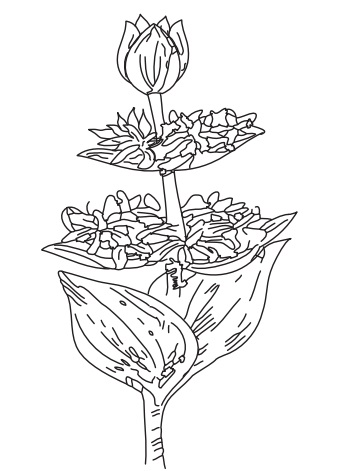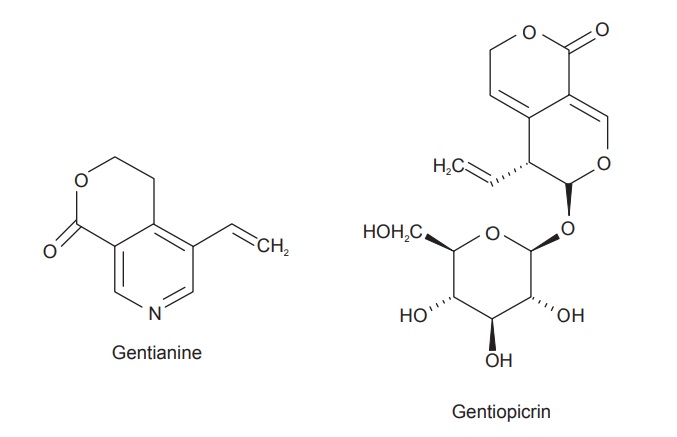Gentian
| Home | | Pharmacognosy |Chapter: Pharmacognosy and Phytochemistry : Drugs Containing Glycosides
Gentian consists of dried unfermented rhizomes and roots of Gentiana lutea Linn., belonging to family Gentianaceae.
GENTIAN
Synonyms
Gentian Root, Yellow Gentian Root.
Biological Source
Gentian consists of dried unfermented rhizomes and roots of Gentiana lutea Linn., belonging to
family Gentianaceae.
Geographical Source
Mountanious regions of Central and south Europe, of France
and Switzerland, of Spain and Portugal, the Pyr-enees, Sardinia and Corsica,
the Apennines, the Mountains of Auvergne, the Jura, the lower slopes of the
Vosges, the Black Forest and throughout the chain of the Alps as far as Bosnia
and the Balkan States.
Cultivation and Collection
It is a perennial plant growing to 1.2 m by 0.6 m. For
cul-tivation, a strong loamy soil is most suitable, the deeper the better, as
the stout roots descend a long way down into the soil. Plenty of moisture is
also desirable and a position where there is shelter from cold winds and
exposure to sunshine. Old plants have large crowns, which may be divided for
the purpose of propagation, but growing it on a large scale, seeds would be the
best method. It is advantageous to keep the seed at about 10°C for a few days
after sowing, to enable the seed to imbibe moisture. Following this with a
period of at least 5–6 weeks with temperatures falling between 0 and –5°C will
usually produce reasonable germination. They could be sown in a frame, or in a
nursery bed in a sheltered part of the garden and the young seedlings
transplanted. They take about three years to grow to flowering size. It is,
however, likely that the roots are richest in medicinal properties before the
plants have flowered.
Collection is done from two to five years old plants in
spring. The rhizome and roots collected and dried. When fresh, they are
yellowish-white externally, but gradually become darker by slow drying. Slow
drying is employed to prevent deterioration in colour and to improve the aroma.
Occasionally the roots are longitudinally sliced and quickly dried, the drug
being then pale in colour and unusually bitter in taste.
Characteristics
When fresh, they are yellowish-white externally, but
gradu-ally become darker by slow drying. Slow drying is employed to prevent
deterioration in colour and to improve the aroma. Occasionally the roots are
longitudinally sliced and quickly dried; the drug being then pale in colour and
unusually bitter in taste, but this variety is not official.
The dried root as it occurs in commerce is brown and
cylindrical, 1 foot or more in length, or broken up into shorter pieces,
usually 1/2 inch to 1 inch in diameter, rather soft and spongy, with a thick
reddish bark, tough and flexible, and of an orange-brown colour internally. The
upper portion is marked with numerous rings, the lower longitudinally wrinkled.
The root has a strong, disagreeable odour, and the taste is slightly sweet at
first, but afterwards very bitter.

Microscopy
The transverse section of root shows triarch primary xylem
at the centre, where each primary bundle is represented by one to three very
small vessels. The secondary xylem is very wide with parenchymatous and
medullary rays not clearly marked. The drug also shows reticulately thickened
xylem vessels very few being annular or spiral, scattered through-out the
parenchyma of the xylem. Secondary phloem is wide and composed chiefly of
parenchyma, with groups of sieve-tissue. The phloems are surrounded by a narrow
parenchymatous phelloderm and externally are several rows of polygonal tabular,
thin walled cork cells. Parenchyma cells in all regions of the root contain
scattered needles of calcium oxalate crystals, about 3–6 μ long and 0.5–1.1 μ wide, also small prismatic
crystals.
Chemical Constituents
Gentian contains bitter glycosides. The dried gentian root
contains Gentinin and Gentiamarin, bitter glucosides, together with Gentianic
acid (gentisin), the latter being physiologically inactive. Gentiopicrin,
another bitter glucoside, a pale yellow crystalline substance, occurs in the
fresh root, and may be isolated from it by treatment with boiling alcohol.
Gentinin, crystalline glycoside is not a pure chemical substance, but a mixture
of gentiopicrin and a colouring substance gentisin (gentianine) or gentlanic
acid. Gentian contains a bitter trisaccharide, gentianose which on hydrolysis
yields two molecules of glucose and one molecule of fructose. The saccharine
constituents of gentian are dextrose, laevulose, sucrose and gentianose, a
crystallizable, fermentable sugar. It is free from starch and yields from 3 to
4% ash.

Uses
Gentian root has a long history of use as an herbal bitter
in the treatment of digestive disorders. It contains some of the most bitter
compounds known and is used as a scientific basis for measuring bitterness. It
is useful in states of exhaustion from chronic disease and in all cases of
debility, weakness of the digestive system and lack of appetite. It is one of
the best strengthened of the human system, stimulating the liver, gall bladder
and digestive system, and is an excellent tonic to combine with a purgative in
order to prevent its debilitating effects.
It is also used as anthelmintic, antiinflammatory,
antiseptic, bitter tonic, cholagogue, emmenagogue, and febrifuge, refrigerant
and stomachic. It is taken internally in the treatment of liver complaints,
indigestion, gastric infections and anorexia. It should not be prescribed for
patients with gastric or duodenal ulcers.
